Engagement Ring Enlargement: A Comprehensive Guide
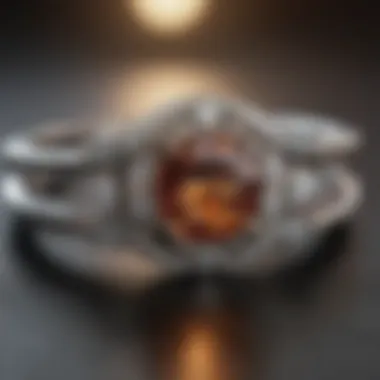
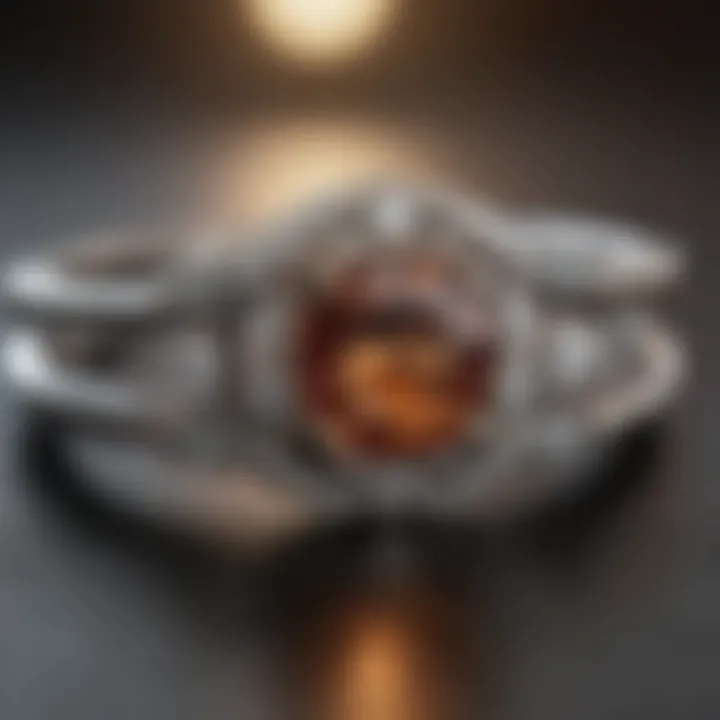
Intro
Engagement rings serve as a significant token of love and commitment. Many factors affect a couple's decision to resize these rings over time. Factors such as changes in finger size or the desire for a new look can prompt resizing. This guide focuses on the processes and considerations involved in engagement ring enlargement while addressing the emotional implications tied to such decisions.
Gemstone Overview
Definition of Gemstones
Gemstones are precious or semi-precious materials, often used in jewelry. These stones can take various forms, from transparent diamonds to colorful sapphires. Generally, gemstones are classified based on their composition, rarity, and the way they are cut and polished. They hold both aesthetic and monetary value, making them sought-after choices in engagement rings.
Classification of Gemstones
Gemstones are classified into two main categories: precious and semi-precious stones. Precious stones include diamonds, rubies, sapphires, and emeralds. These are the most renowned due to their rarity and beauty. Semi-precious gemstones offer diversity in color and appeal, including amethyst, citrine, and garnet. Understanding these classifications can help individuals select the right stone for resizing purposes.
Historical Significance
Origins of Gemstone Use
The use of gemstones dates back thousands of years. Ancient cultures regarded gemstones as symbols of power, protection, and love. They were often engraved with inscriptions to honor deities or serve as tools for spiritual practices. As time passed, their roles evolved, particularly in the realm of wedding and engagement jewelry.
Cultural Insights: Gemstones in Ancient Civilizations
Many ancient civilizations hold unique relationships with gemstones. For example, the Egyptians believed that lapis lazuli had protective properties. Similarly, the Greeks associated amethyst with moderation. The meanings of gemstones have shifted through the centuries, influencing how they are thought of in contemporary times.
In many cultures, the tradition of gifting a ring during engagements has deep roots, interwoven with the symbolic meanings of gemstones.
Importance of Professional Guidance
When considering resizing, it is crucial to seek professional guidance. Not all materials and settings can withstand resizing processes. A gemologist or jeweler can evaluate the design and provide tailored recommendations to ensure the ring's integrity is maintained. This is especially significant for intricate settings or rings containing multiple stones.
Culmination
Engagement ring enlargement involves understanding gemstones, their classifications, and historical contexts. Additionally, consulting with a professional plays an essential role in ensuring a successful resizing. Knowledge of these elements can enrich the emotional significance of the ring, making it more than just a token but a true reflection of one's journey together.
Understanding Engagement Ring Enlargement
Engagement ring enlargement is a relevant topic for many who cherish their jewelry. It addresses the need for resizing when fingers change due to various factors. Despite its complexity, understanding the nuances of this process is crucial. An enlargement can maintain the ring's beauty while ensuring comfort for the wearer. Moreover, it allows individuals to preserve the sentimental value attached to the piece, especially if it has deep emotional significance.
Defining the Concept of Enlargement
Enlargement refers to the process of adjusting an engagement ring so that it fits comfortably on the finger. It involves either stretching the band or adding material to increase the ring's size. With both methods, the goal remains the same: to create a fit that reflects the owner’s wishes and needs. This resizing ensures that the ring continues to serve as a symbol of love without causing discomfort. It is not merely a physical adjustment but also a way to maintain a connection to a cherished moment in one’s life.
Importance in the Context of Jewelry
The importance of engagement ring enlargement goes beyond mere functionality. Many individuals view their engagement rings as permanent fixtures in their lives. A proper fit is essential, not just for comfort but also for the integrity of the piece. An ill-fitting ring may lead to loss or damage, diminishing its sentimental and financial value.
In the realm of jewelry, an enlarged ring can rejuvenate the piece, allowing it to be worn with newfound pride. Furthermore, resizing can sometimes enhance the visual appeal of the ring, as a well-fitted ring allows for better visibility of its design and stones.
"Proper ring sizing ensures both comfort and the enduring beauty of a cherished piece."
Overall, understanding the process of engagement ring enlargement equips wearers with knowledge. It empowers them to make informed decisions about their jewelry. Whether due to changing body sizes or lifestyle shifts, the importance of this topic cannot be overlooked.
Reasons for Ring Enlargement
Understanding the reasons for ring enlargement is crucial for anyone considering the process. An engagement ring, often considered a significant symbol of commitment, may not fit as perfectly over time as it did on the day it was received. Various factors influence the need for resizing, each with its own considerations. A well-informed decision about enlargement ensures that the ring remains wearable and continues to symbolize the love and commitment it represents.
Changes in Finger Size
Finger sizes can change due to numerous factors. These may include weight fluctuations, temperature variations, or even medical conditions. As one ages, it's common for fingers to swell or become daintier. For some, seasonal changes can cause the skin and tissues to expand or contract. In addition, certain activities might temporarily alter the fit, leading to discomfort or difficulty wearing the ring.


Knowing signs that indicate a need for enlargement is essential, such as the ring feeling tight, leaving indent marks, or slipping off easily. Addressing these changes promptly can prevent damage to the ring and ensures it remains comfortable.
Lifestyle Factors
Lifestyle choices play a significant role in how the fit of an engagement ring can change. Athletes, for example, often experience fluctuations in finger size due to increased activity levels or temperature changes. Pregnant individuals might see substantial changes due to fluid retention, necessitating resizing during or after their pregnancy.
Routine habits such as weight lifting or even frequent use of hand creams can also affect how snugly a ring fits. When lifestyle changes occur, it is essential to assess the appropriateness of the ring's size.
Sentimental Value of the Ring
The emotional aspect of resizing cannot be overlooked. Engagement rings often carry deep personal significance. They can symbolize milestones, family heritage, or cherished memories. When considering enlargement, one should not only focus on fit but also acknowledge the emotional attachment.
Resizing a ring can sometimes evoke feelings of concern over losing a part of its character. However, achieving a comfortable fit usually enhances the joy of wearing the ring, ensuring it remains a part of daily life.
"The ring is not just a piece of jewelry; it’s a tangible reminder of promises made and love shared."
Ultimately, understanding these reasons provides clarity. It emphasizes that engagement ring resizing is not merely a technical alteration but a thoughtful response to evolving personal circumstances.
Methods of Enlargement
Understanding the various methods of engagement ring enlargement is crucial for ensuring comfort, durability, and aesthetic appeal after resizing. Each technique has specific attributes that influence the appearance and longevity of the ring. Moreover, selecting the right method can benefit not only the wearer but also conserve the ring’s original charm and significance. Here, we explore the most common approaches to ring enlargement, their benefits, and considerations to keep in mind.
Stretching the Band
Stretching the band is one method often employed to enlarge an engagement ring. This process involves gently pulling the metal band to create a larger circumference. The primary advantage of stretching is that it maintains the integrity of the ring's original design without adding any new material.
However, stretching may only work effectively on certain types of metals, such as gold or silver, which are malleable. Additionally, this method is limited by the amount of stretch possible without compromising the band’s structural integrity. Overstretching can result in a weakened band, making it essential to consult with a professional to determine the right extent for resizing.
Adding Metal to the Band
Adding metal to the band is another common technique for enlargement. This approach is particularly beneficial when the required size increase is significant. Jewelers will remove the ring and insert a metal piece into the band, which can be composed of the same or a compatible metal.
A notable advantage of this method is its versatility. Whether the ring is platinum, gold, or another metal, skilled jewelers can often match the original seamlessly. However, this method may alter the ring's original design slightly, depending on how the new metal is integrated. It can also affect the cost, as more materials are required.
Alternative Methods
Alternative methods offer innovative solutions for ring enlargement that may suit specific needs or preferences.
Using Resizing Shims
Using resizing shims provides a temporary solution for those seeking a quick fix without permanent changes. Shims are small inserts that can be placed inside the ring band to create a snugger fit. They are typically made of materials like plastic or metal and can easily be removed or changed.
The key characteristic of resizing shims is their non-invasive nature. Since they do not alter the band’s structure, they allow for flexibility in sizing adjustments. This can be especially beneficial for individuals whose finger sizes fluctuate due to seasonal changes or weight variations.
However, some shims may be visible within the band, which could detract from the ring's aesthetic appeal. They require careful monitoring and can be less comfortable compared to more permanent solutions.
Adjusting the Setting
Adjusting the setting is another viable option, especially when the stone setting becomes loose after a resize. This method not only ensures that the gemstone sits securely but can also add to the overall appearance of the ring.
A notable advantage of adjusting the setting is that it allows for customization to fit the new size while preserving the design integrity. Additionally, this can be an opportunity to refresh the ring without a complete overhaul. The disadvantage might arise in costs and the need for a skilled jeweler to ensure that the adjustment does not compromise the setting's strength.
The variety of methods discussed demonstrates that there are practical solutions to achieving a proper fit. Understanding these techniques can inform better decisions regarding engagement ring resizing.
Material Considerations
When it comes to engagement ring enlargement, the material considerations play a crucial role. Understanding the materials used in rings can determine both the feasibility of resizing and the potential impact on the ring's overall integrity, appearance, and longevity. Knowing the composition of the metal can aid in making informed decisions during the resizing process.
Types of Metals Used in Rings
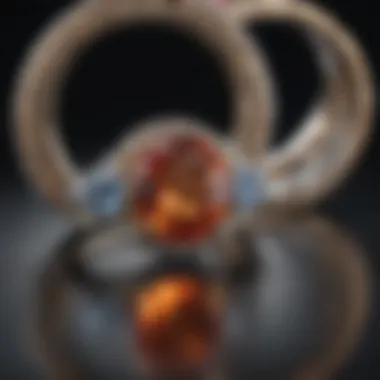
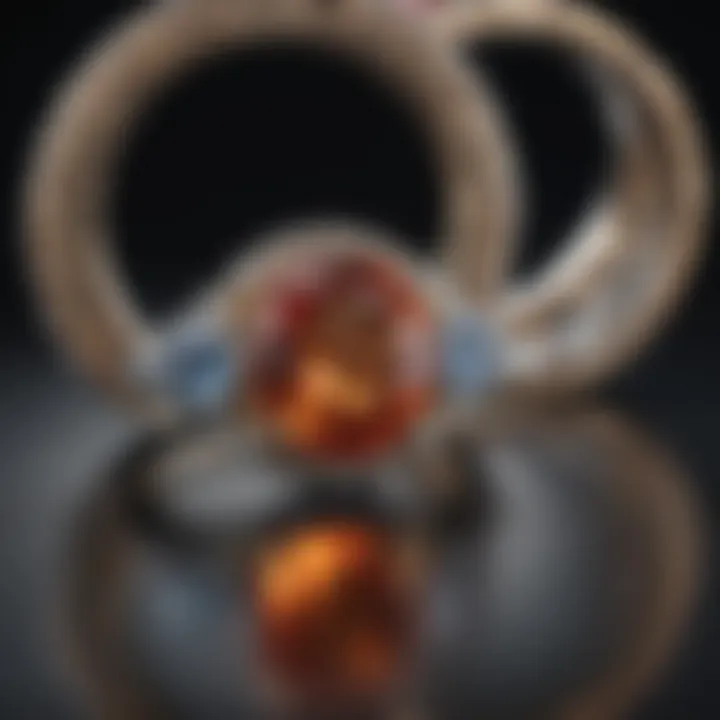
Engagement rings are typically made from a variety of metals, each offering different benefits and challenges in the resizing process. Common metals used include:
- Gold: Available in yellow, white, and rose variations, gold is malleable, making it easier to resize. However, the karat (purity) affects its durability. 14K and 18K gold are popular choices for engagement rings.
- Platinum: This metal is known for its strength and hypoallergenic properties. It is more difficult to resize due to its density, but it offers a lasting shine and durability.
- Silver: Less commonly used for engagement rings, silver is softer and could wear down over time. Its affordability makes it appealing, but it may require more frequent resizing and maintenance.
- Palladium: A member of the platinum group, palladium shares many properties with platinum but is lighter and often more affordable. It can be resized but should be handled carefully to avoid damage.
- Titanium: Known for its lightweight and strength, titanium is harder to resize due to its toughness. Its unique look captures attention but presents challenges during the enlargement process.
Each of these metals influences how a ring can be resized. A jeweler’s familiarity with these materials is important for achieving a successful and effective enlargement.
Impact on the Enlargement Process
The type of metal used in an engagement ring significantly impacts the resizing process. Understanding these implications can help set realistic expectations when approaching a jeweler for alterations.
- Malleability and Ductility: Malleable metals like gold are easier to stretch or bend, making resizing somewhat straightforward. On the other hand, metals like titanium are less malleable. This means they require specialized tools and techniques for resizing and may not be able to be adjusted as much in size.
- Durability: Some metals resist scratches and dents better than others. For instance, platinum is less likely to show wear and tear compared to gold. Resizing a durable metal is often less concerning than resizing one that is more prone to damage.
- Visual Consistency: After enlargement, matching the color and luster of the ring is essential to maintain its aesthetic value. Platinum retains its appearance well, while gold alloys may need replating if the metal wears down during the resizing process.
- Cost Implications: Some metals may increase the cost of resizing significantly. For example, platinum typically costs more to resize than standard gold due to its density and the expertise required to work with it.
Before proceeding with any resizing operation, both the type of metal and the desired outcome should be discussed with a professional. Expert advice ensures that the end result aligns closely with the expectations placed on this meaningful piece of jewelry.
Professional Evaluation
Engagement ring enlargement is not a simple task. The professional evaluation of a ring is crucial for several reasons. First, experts possess the knowledge to assess the structural integrity and material of the ring. This means they can determine the best method for resizing. An expert will ensure the enlargement does not compromise the ring's design or durability.
In addition, professional evaluation helps in understanding the emotional significance behind the ring. Jewelers with experience recognize that these rings often carry sentimental value. Unless handled properly, resizing could lead to unintended personal consequences. Thus, a professional will consider both physical and emotional aspects during the evaluation.
Another key point is the efficiency of the resizing process. An experienced jeweler can perform the enlargement in a timely manner, minimizing the disruption to the wearer's life. By choosing a qualified professional, customers can expect higher quality work, which leads to lasting results.
"Consultation with a professional can mean the difference between a ring that feels right on your finger and one that feels like a burden."
Ultimately, seeking a professional evaluation not only guarantees the right approach but also instills confidence in the final result.
Importance of Expert Consultation
A knowledgeable jeweler brings extensive experience to the table. Consulting with an expert enables wearers to explore various resizing options tailored to the specific ring and their needs. Not all rings respond the same way to resizing. A consultation helps identify suitable methods, such as stretching or adding material.
Furthermore, an expert helps avoid common mistakes made by individuals attempting do-it-yourself approaches. Slightly enlarging a band often results in the loss of shape, or can disturb the setting. These issues may ultimately lead to costly repairs and, in some cases, complete loss of the ring's appeal.
Involving experts can also provide insight into potential future complications. For example, if the engagement ring is part of a set, it may influence how resizing is approached. Overall, consulting an expert ensures a more successful enlargement process.
Choosing a Qualified Jeweler
Choosing the right jeweler for engagement ring enlargement requires careful consideration. The first step is to evaluate the jeweler's credentials, including certifications and training. A qualified jeweler should have a good reputation in the jewelry community.
Recommendations from friends, family, or online reviews can offer valuable insights into a jeweler’s quality. Seek those who specialize in resizing, specifically with engagement rings.
Additionally, visiting the jeweler's workshop can provide assurance regarding their capabilities. Observing their workspace can reveal the tools and techniques they employ. A clean and organized environment is a positive indicator of professionalism and attention to detail.
Communication is also important. A qualified jeweler should be willing to answer questions about the resizing process and explain the potential risks involved. This transparency fosters trust, helping clients feel more comfortable with their decision.
Emotional and Symbolic Implications
Engagement rings are not just pieces of jewelry; they carry a profound emotional weight and represent significant life milestones. Understanding the emotional and symbolic implications of engagement ring enlargement is crucial, as it can affect both the wearer's relationship with the ring and its inherent meaning over time.
Emotional Attachment to the Ring
The emotional connection to an engagement ring often transcends the metal and stones used in its construction. This bond is frequently tied to memories, commitments, and love. When resizing a ring, individuals may experience a range of feelings, from excitement about the new fit to anxiety about altering something so pivotal to their relationship.
Many people view engagement rings as a tangible expression of love and commitment. These rings often mark pivotal moments in life, such as a proposal or the beginning of a new chapter in a couple's journey. Therefore, resizing can provoke curiosity and concern. Will the resized ring still resonate with the same emotional weight? Maintaining the original charm while accommodating changes in fit is a top priority.
Moreover, resizing can invoke thoughts of change in personal identity. Fingers can grow or shrink due to various factors, and resizing may feel like an external representation of internal transformations. This complexity adds layers to the emotional attachment.
Changes in Symbolism after Enlargement
The symbolism of an engagement ring is deeply affected by alterations. Traditionally, engagement rings symbolize commitment and love, and any modification can shift their meaning.
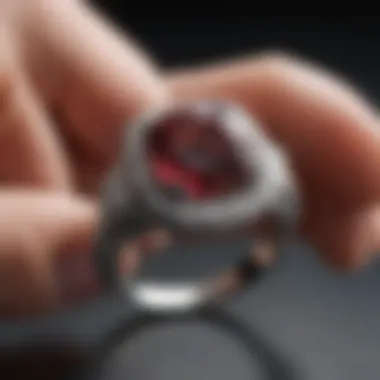

Resizing a ring might alter how it reflects the relationship it embodies. For some, enlarging the ring might suggest growth in the relationship, symbolizing stability and adaptation over time. However, others might worry that resizing diminishes the original intent of the piece, leading to conflicting feelings about the change.
"Resized rings need not lose their emotional resonance; it often comes down to the perception of the owner."
After resizing, it’s common for the ring to feel both familiar and foreign. This duality can prompt wearers to reassess the symbolism of their rings. Engaging with a jeweler who understands the nuances of symbolism can help individuals navigate these changes and aid in reframing the meaning of the resized item.
Post-Resizing Care
After resizing an engagement ring, proper care is crucial to ensure its longevity and maintain its new fit. Caring for the ring includes monitoring its condition, addressing potential issues early on, and following specific maintenance practices that can prevent further resizing in the future. Engaging with your ring thoughtfully can enhance your overall jewelry experience.
Maintenance Tips
- Regular Cleaning: Regularly clean your engagement ring to keep it sparkling. Use a gentle soap and water solution with a soft brush. Avoid abrasive cleaners, as they can damage the finish.
- Avoid Harsh Chemicals: Chemicals in cleaning products or swimming pools can adversely affect the metal and stones in your ring. Always remove your ring before using strong cleaning agents or entering chlorinated water.
- Inspect for Loose Stones: Regularly check for any loose stones. Gently push them to see if they move. If any stone seems loose, take it to a jeweler immediately for inspection.
- Store Properly: When not wearing your engagement ring, store it in a soft cloth or a jewelry box away from other pieces to avoid scratches.
- Be Mindful of Activities: Remove your ring when doing specific activities, such as exercising or manual labor. Doing so reduces the risk of damaging the band or dislodging stones.
These maintenance tips can significantly extend the life of your ring.
Future Adjustments and Monitoring Fit
After resizing, it is important to monitor how the ring fits on your finger over time. Finger sizes can change due to various factors, including weight fluctuations, temperature changes, or even health conditions.
Regularly assess the comfort and fit of your ring. If you notice any tightness or looseness, it's advisable to consult with a professional jeweler for adjustments.
- Timely Resizing: If the ring feels too tight or slips off easily, addressing these issues sooner rather than later can prevent further complications.
- Professional Check-Ups: Consider scheduling a check-up with your jeweler every six months. They can assess both the ring's condition and its fit and make recommendations based on wear and tear.
- Maintain a Comprehensive Record: Keeping a record of any maintenance or adjustments done can help track the ring's history, which may be useful for any future resizing needs.
"Regular care and observation can preserve the integrity of your engagement ring, keeping it a cherished symbol of love for years to come."
With careful attention to post-resizing care, you can ensure that your engagement ring remains beautiful and well-fitted.
Common Myths about Engagement Ring Resizing
Engagement ring resizing is surrounded by many misconceptions that can confuse people looking to alter their cherished jewelry. Understanding these myths is essential for anyone contemplating resizing their ring. By breaking down these common myths, we can clarify the reality behind engagement ring resizing. This knowledge not only helps in making informed decisions but also eases anxiety associated with the adjustment process. Moreover, dispelling these myths can highlight the value of professional assistance in ensuring the ring's integrity remains intact.
Myth vs. Reality in Resizing
Resizing Ruins the Ring
One prevalent myth is that resizing an engagement ring will ruin it. This concern primarily stems from a lack of understanding about the resizing process itself. In reality, when done correctly, resizing preserves the ring’s original design and characteristics. Professional jewelers employ specific techniques that carefully manipulate the metal and the stone's setting. This allows for an almost seamless adjustment that does not compromise the overall appearance.
The key aspect here is choosing a skilled jeweler. With appropriate expertise, the ring can be resized to fit comfortably, without losing its aesthetic value. The unique feature of this myth is that it disregards the advancements in jewelry repair techniques. As a result, resizing offers a practical solution rather than a detrimental effect on the ring. The benefits of resizing include improved fit and comfort, maximizing the ring’s potential for daily wear.
Resizing is Too Expensive
The belief that resizing an engagement ring is prohibitively expensive also merits examination. It is true that resizing can incur costs; however, these expenses are often more manageable than many assume. The cost is determined by factors like the complexity of the resizing, the type of metal, and the jeweler’s experience.
A significant benefit of engaging a professional for this task is that they provide transparent pricing options. Additionally, resizing can save future costs associated with replacing the ring due to discomfort or loss. The unique element of this myth lies in the perception of value: while upfront costs might seem steep, the long-term benefits — such as enhanced comfort and usability — justify the investment. Careful consideration of these aspects reveals that resizing can be a worthwhile choice for maintaining the ring’s significance and wearability.
"Understanding the myths surrounding engagement ring resizing is key to making informed and confident decisions."
Resizing holds substantial advantages, especially when approached correctly and with the right guidance. Recognizing these myths allows individuals to view resizing not as a risky endeavor, but as a necessary step to preserve their treasured symbols of love.
Ending
The decision to enlarge an engagement ring can stem from various reasons. A shift in finger size, changes in lifestyle, or a renewed emotional connection can all prompt an individual to consider resizing. Recognizing these motivations is essential to appreciate the finer details of engagement ring enlargement.
Recap of Important Points
When summarizing the major themes discussed, a few key points stand out:
- Definition and Importance: Engagement ring enlargement involves adapting a ring's size to ensure a comfortable and aesthetically pleasing fit. Its importance lies in maintaining the sentimental value associated with the ring.
- Methods of Enlargement: Various techniques exist for enlarging a ring, including band stretching and the addition of metal. The choice of method can depend on the specific ring design and the materials used.
- Professional Evaluation: Consulting a qualified jeweler is crucial. Their expertise ensures that the process respects the integrity of the original design while effectively achieving the desired size.
- Post-Resizing Care: After resizing, proper maintenance can prolong the life and quality of the ring. Regular monitoring of fit and condition is advisable.
Final Thoughts on Engagement Ring Enlargement
Engagement ring enlargement is more than a practical adjustment; it signifies a deeper connection to a symbol of love and commitment. The emotional weight of a ring often makes resizing a personal and sensitive endeavor. By approaching the topic with thoughtful consideration and a proper understanding of methods and implications, individuals can ensure that their engagement rings continue to represent their unique journeys.
As you reflect on the insights shared in this article, remember that resizing does not solely alter the physical dimensions of the jewelry but can also enhance its meaning in your life. The careful balance of practical and emotional aspects can lead to a thoughtful and satisfactory resizing experience.



